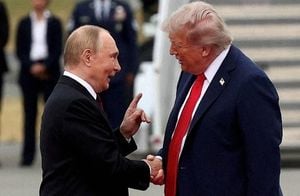Chip giant Nvidia, a linchpin in the artificial intelligence (AI) revolution, has once again defied Wall Street expectations, reporting $46.7 billion in revenue for the three months ending July 2025. This figure, which outpaced analyst forecasts of $46.2 billion, marks a 56% surge from the same quarter last year, according to ABC News and Axios. The company’s net income also ballooned by 59% to $26.4 billion, reinforcing Nvidia’s status as a dominant engine behind the AI-driven boom that has electrified U.S. stock markets and the broader economy.
Yet, beneath the celebratory headlines, Nvidia faces a landscape fraught with geopolitical intrigue, regulatory uncertainty, and questions about the sustainability of AI’s meteoric rise. The company’s relationship with China, the world’s second-largest economy, has become particularly complicated, with U.S. government policy and Beijing’s own restrictions shaping the future of chip sales in unpredictable ways.
Earlier this year, President Donald Trump imposed a temporary ban on the sale of Nvidia’s advanced chips to China, citing national security concerns. The ban was lifted in July 2025, but not without conditions. In August, Trump announced a deal allowing Nvidia to resume exports to China—if the company agreed to hand over 15% of its China-derived revenue to the U.S. Treasury. “I said, ‘If I’m going to do that, I want you to pay us as a country something, because I’m giving you a release,’” Trump recounted at a White House event, as reported by ABC News.
But the plan, as it turns out, is anything but straightforward. According to Bloomberg, Nvidia’s Chief Financial Officer Colette Kress clarified that the company cannot pay the U.S. a 15% commission on AI chip sales to China until the Trump administration’s plan is formalized into actual regulation. “Discussions with the U.S. government are ongoing,” Kress stated, emphasizing that the proposal hasn’t progressed beyond early stages and could pose legal risks if not properly structured.
Meanwhile, Nvidia’s business in China has ground to a halt. The company reported that it did not sell any of its H20 chips in China during the most recent quarter, and it does not expect to sell any in the current quarter either. The reason? According to Axios, Beijing has reportedly instructed Chinese companies not to buy the H20 chips, citing both security concerns and dissatisfaction with the chips’ downgraded specifications—changes made by Nvidia to comply with U.S. export controls. This standoff has left a multibillion-dollar market in limbo, with Nvidia’s CEO Jensen Huang estimating on an earnings call that the Chinese market could be worth $50 billion in revenue next year and might grow by 50% annually, if reopened.
Despite these headwinds, Nvidia’s core businesses remain robust. The company’s critical data center segment, which supplies the chips powering everything from generative AI tools to cloud computing platforms, saw revenue leap 56% to $41.1 billion. However, sequential growth from the previous quarter was just 5%, hinting at a possible slowdown as the sector matures, Axios noted.
Looking ahead, Nvidia forecasted $54 billion in sales for the upcoming third quarter. While this figure aligns with the average Wall Street estimate, some analysts had hoped for more than $60 billion, according to Bloomberg. The lower guidance is partly due to the ongoing freeze in China; Nvidia is not incorporating any potential resumption of H20 chip sales in its outlook. Still, CFO Colette Kress said that if geopolitical issues are resolved, the company could reap between $2 billion and $5 billion in third-quarter revenue from China alone.
The market’s reaction to Nvidia’s latest earnings was muted. Shares dipped 2-4% in after-hours trading following the report, reflecting investor jitters about the company’s China prospects and the broader AI sector’s sustainability. Nvidia now represents about 8% of the S&P 500 index, the highest weighting for any single stock since data collection began in 1981, according to Apollo Global Management chief economist Torsten Sløk.
This outsized influence has made Nvidia a bellwether for the entire AI industry—and, by extension, the U.S. economy. AI-related spending added a 0.5 percentage point boost to annualized gross domestic product growth over the first half of 2025, according to Pantheon Macroeconomics. The company’s rapid ascent—its stock price has soared nearly 700% since the release of OpenAI’s ChatGPT in 2022—has fueled both exuberance and anxiety on Wall Street.
Not everyone is convinced that the AI party will last. In recent weeks, some high-profile voices have warned of a potential bubble. Torsten Sløk, for instance, suggested that the current AI boom may even surpass the dot-com bubble of the late 1990s, raising concerns about overvaluation. OpenAI CEO Sam Altman echoed this sentiment in an interview with The Verge: “Are we in a phase where investors as a whole are overexcited about AI? My opinion is yes. Is AI the most important thing to happen in a very long time? My opinion is also yes.”
For now, Nvidia’s leadership remains focused on navigating the regulatory maze and geopolitical tensions that define the modern chip industry. The company is in ongoing discussions with the U.S. government about how—and whether—to implement the proposed 15% revenue-sharing arrangement for China sales. Legal uncertainties abound, and the ultimate fate of this unprecedented deal remains unclear.
Meanwhile, the standoff with Beijing continues to cast a long shadow. Chinese authorities’ refusal to approve Nvidia’s H20 chips, combined with the U.S. government’s evolving stance, has left billions of dollars in potential revenue on the table. As Nvidia’s CFO Colette Kress put it, the company’s outlook for China hinges on “if geopolitical issues reside” and “if we have more orders, we can build more.”
With the AI sector now a central pillar of the U.S. economy—and Nvidia at its heart—investors, policymakers, and technologists alike are watching closely. Will the Chinese market open up again? Can Nvidia maintain its breakneck growth if it doesn’t? And what happens if the much-feared AI bubble finally bursts?
One thing is certain: Nvidia’s latest results underscore both the extraordinary potential and the profound uncertainty that define the AI era. The company’s next moves, and the policies that shape them, will ripple far beyond Silicon Valley.




